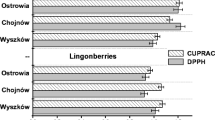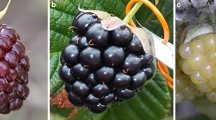Abstract—
Extracts and their concentrates can be considered as a source of biologically active ingredients of food products and as food additives to increase the consumption of useful substances of berries. The benefits gained from their use lead to the development of advanced technologies that can allow them to be extracted from the feedstock without significantly compromising the biological activity of the feedstock. In this paper, we studied the content of antioxidants and their activity in concentrated extracts of cranberry (Vaccinium oxycoccus), sea buckthorn (Hippophae rhamnoides L.), blackberry (Rubus fruticosus), guelder rose (Viburnum opulus L.) and mountain ash (Sorbus aucuparia L.) berries. For all extracts, the total content of phenolic compounds, flavonoids and anthocyanins, antioxidant activity according to the DPPH method and iron-reducing antioxidant activity (FRAP) were determined. Concentrated extracts of guelder rose contain the largest amount of phenolic compounds (9.3 ± 0.3 mol HA/L) , flavonoids (1.96 ± 0.08 mol K/L) and anthocyanins (0.26 ± 0.02 mol CG/L) among the studied extracts. There is also a high total content of phenolic substances and flavonoids in blackberry and rowan extracts (5.7 mol HA/L, 1.33 mol K/L and 4.7 mol HA/L, 192 mol K/L, respectively) . The antioxidant activity of the extract of guelder rose berries showed a directly proportional dependence on the content of biologically active compounds in it: DPPH-method, 2.4 mg/mL; FRAP-method, 39.99 mmol Fe2+/kg. Also, high levels were found in concentrated extracts of blackberries, sea buckthorn and mountain ash. It is the extracts of guelder rose, blackberry and mountain ash that are recommended to be used in the production of food products to enrich them with biologically active substances and give them antioxidant properties. Cranberry and sea buckthorn extracts can be used in combination with other extracts.



Similar content being viewed by others
REFERENCES
Yang, B. and Kortesniemi, M., Clinical evidence on potential health benefits of berries, Curr. Opin. Food Sci., 2015, vol. 2, pp. 36–42. https://doi.org/10.1016/j.cofs.2015.01.002
Rodriguez-Mateos, A. et al., Berry (poly)phenols and cardiovascular health, J. Agric. Food Chem., 2014, vol. 62, no. 18, pp. 3842–3851. https://doi.org/10.1021/jf403757g
Sevenich, R. and Mathys, A., Continuous versus discontinuous ultra-high-pressure systems for food sterilization with focus on ultra-high-pressure homogenization and high-pressure thermal sterilization: A review, Compreh. Rev. Food Sci. Food Safety, 2018, vol. 1, pp. 1–17. https://doi.org/10.1111/1541-4337.12348
Skrovankova, S. et al., Bioactive compounds and antioxidant activity in different types of berries, Int. J. Mol. Sci., 2015, vol. 16, no. 10, pp. 24673–24706. https://doi.org/10.3390/ijms161024673
Nowacka, M. et al., Changes of mechanical and thermal properties of cranberries subjected to ultrasound treatment, Int. J. Food Eng., 2017, vol. 13. https://doi.org/10.1515/ijfe-2016-0306
Nowacka, M. et al., Effect of ultrasound treatment during osmotic dehydration on bioactive compounds of cranberries, Ultrasonics, 2018, vol. 83, pp. 18–25. https://doi.org/10.1016/j.ultras.2017.06.022
Wei, E. et al., Microwave-assisted extraction releases the antioxidant polysaccharides from seabuckthorn (Hippophae rhamnoides L.) berries, Int. J. Biol. Macromol., 2019, vol. 123, pp. 280–290. https://doi.org/10.1016/j.ijbiomac.2018.11.074
Zielinska, A. and Nowak, I., Abundance of active ingredients in sea-buckthorn oil, Lipids Health Disease, 2017, vol. 16, no. 1, pp. 95–106. https://doi.org/10.1186/s12944-017-0469-7
Marsinach, M.S. and Cuenca, A.P., The impact of sea buckthorn oil fatty acids on human health, Lipids Health Disease, 2019, vol. 18, no. 1, p. 145. https://doi.org/10.1186/s12944-019-1065-9
Pundir, S. et al., Ethnomedicinal uses, phytochemistry and dermatological effects of Hippophae rhamnoides L.: A review, J. Ethnopharmacol., 2021, vol. 266, p. 113459. https://doi.org/10.1016/j.jep.2020.113459
Ciesarova, Z. et al., Why is sea buckthorn (Hippophae rhamnoides L.) so exceptional? A review, Food Res. Int., 2020, vol. 133, p. 109170. https://doi.org/10.1016/j.foodres.2020.109170
Tomas, M. et al., Effect of different soluble dietaryfibres on the phenolic profile of blackberrypuree subjected toin vitrogastrointestinal digestion and large intestinefermentation, Food Res. Int., 2020, vol. 130, p. 1089542. https://doi.org/10.1016/j.foodres.2019.108954
Nogueira, G. et al., Incorporation of spray dried and freeze dried blackberry particles in edible films: Morphology, stability to pH, sterilization and biodegradation, Food Packag. Shelf Life, 2019, vol. 20, p. 100313. https://doi.org/10.1016/j.fpsl.2019.100313
Kraujalyte, V. et al., Antioxidant properties and polyphenolic compositions of fruits from different european cranberrybush (Viburnum opulus L.) genotypes, Food Chem., 2013, vol. 141, pp. 3695–3702. https://doi.org/10.1016/j.foodchem.2013.06.054
Barak, H. et al., Influence of in vitro human digestion on the bioavailability of phenolic content and antioxidant activity of Viburnum opulus L. (European cranberry) fruit extracts, Ind. Crops Products, 2019, vol. 131, pp. 62–69. https://doi.org/10.1016/j.indcrop.2019.01.037
Ersoy, N. et al., Evaluation of European cranberrybush (Viburnum opulus L.) genotypes for agro-morphological, biochemical and bioactive characteristics in turkey, Folia Horticult., 2017, vol. 29, pp. 181–188. https://doi.org/10.1515/fhort-2017-0017
Shikov, A.N. et al., Medicinal plants of the Russian pharmacopoeia; their history and applications, J. Ethnopharmacol., 2014, vol. 154, no. 3, pp. 481–536. https://doi.org/10.1016/j.jep.2014.04.007
Zymone, K. et al., Phytochemical profiling of fruit powders of twenty Sorbus L. cultivars, Molecules, 2018, vol. 23, no. 10, p. 2593. https://doi.org/10.3390/molecules23102593
Bobinaite, R. et al., Chemical composition, antioxidant, antimicrobial and antiproliferative activities of the extracts isolated from the pomace of rowanberry (Sorbus aucuparia L.), Food Res. Int., 2020, vol. 136, p. 109310. https://doi.org/10.1016/j.foodres.2020.109310
Baby, B. et al., Antioxidant and anticancer properties of berries, Crit. Rev. Food Sci. Nutrit., 2018, vol. 58, no. 15, pp. 2491–2507. https://doi.org/10.1080/10408398.2017.1329198
Eremeeva, N.B. et al., Ultrasonic and microwave activation of raspberry extract: Antioxidant and anti-carcinogenic properties, Foods Raw Mater., 2019, vol. 7, no. 2, pp. 264–273. https://doi.org/10.21603/2308-4057-2019-2-264-273
Cai, M. et al., Behavior and rejection mechanisms of fruit juice phenolic compounds in model solution during nanofiltration, J. Food Eng., 2017, vol. 195, pp. 97–104. https://doi.org/10.1016/j.jfoodeng.2016.09.024
Demidova, A.V. et al., Influence of blanching on the physical and chemical properties and antioxidant activity of fruit raw materials cherries, plums, blank chokeberry, strawberry, Pishch. Prom-st’., 2016, no. 2, pp. 40–43.
Stryukova A.D. et al., Frozen berries – effective antioxidant for whole year, Pishch. Prom-st’, 2013, no. 3, pp. 28–31.
Cheigh, C.I. et al., Enhanced extraction of flavanones hesperidin and narirutin from citrus unshiu peel using subcritical water, Int. J. Food Eng., 2012, vol. 110, no. 3, pp. 472–477. https://doi.org/10.1016/j.jfoodeng.2011.12.019
M’hirin, N. et al., Effect of different operating conditions on the extraction of phenolic compounds in orange peel, Food Bioprod. Process., 2015, vol. 69, pp. 161–170. https://doi.org/10.1016/j.fbp.2015.07.010
Hajimehdipoor, H. et al., Investigating the synergistic antioxidant effects of some flavonoid and phenolic compounds, Res. J. Pharmacogn., 2014, vol. 1, no. 3, pp. 35–40.
Author information
Authors and Affiliations
Corresponding author
Ethics declarations
The authors declare that they have no conflicts of interest. This article does not contain any studies involving animals or human participants performed by any of the authors.
Additional information
Translated by E. Makeeva
Rights and permissions
About this article
Cite this article
Eremeeva, N.B., Makarova, N.V. Study of the Content of Antioxidants and Their Activity in Concentrated Extracts of Cranberry (Vaccinium oxycoccus), Sea Buckthorn (Hippophae rhamnoides L.), Blackberry (Rubus fruticosus), Guelder Rose (Viburnum opulus L.) and Mountain Ash (Sorbus aucuparia L.). Russ J Bioorg Chem 48, 1392–1398 (2022). https://doi.org/10.1134/S1068162022070044
Received:
Revised:
Accepted:
Published:
Issue Date:
DOI: https://doi.org/10.1134/S1068162022070044




